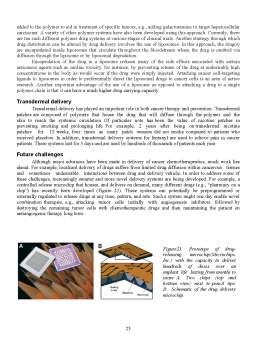Cuprins
- 1. Introduction 3
- 2. General Information 3
- Polymers 3
- Importance and uses 3
- Unique characteristics 5
- Drug Delivery 5
- Functions 5
- Types of carrier systems 5
- Hydrogels 7
- 3. Polymer drug controlled-delivery systems 7
- Advantages and disadvantages 7
- Biomaterials for delivery systems 8
- Factors Affecting Biodegradation of Polymers 9
- Mechanism of drug release 9
- Diffusion- Controlled Systems 10
- Water Penetration-Controlled Systems 11
- Environmentally Responsive Systems 12
- Thermo-responsive controlled-release systems 13
- External stimulants (magnetism, ultrasound) 13
- Biodegradable systems 14
- Degradation mechanism in Oral Delivery Systems 14
- Mechanisms of Intestinal-Specific Polymeric Degradation 14
- Chemomechanical Polymers 15
- Automatic drug Delivery Systems 15
- Applications 16
- 4. Preparation methods for polymer controlled-delivery systems 16
- Acid-sensitive copolymer micelles 16
- Micelles formed from block copolymers containing weak acid or base functions 17
- Crosslinkable Micellar systems 18
- 5. Medical Applications 20
- Ophthalmic drug delivery systems 20
- Polymeric systems for sustaining release 20
- Biocompatibility and biodegradability 20
- Cancer therapeutics drug delivery systems 21
- Local chemotherapy 22
- Targeted delivery and altering pharmacokinetics 22
- Transdermal delivery 23
- Future challenges 23
- 6. Inorganic Polymers 24
- 7. Biomedical imaging 24
- 8. Bibliography 25
Extras din curs
1. Introduction
Controlled release drug delivery is a new way to treat illnesses. The term controlled release refers to the ability of a drug delivery system to release a drug over an extended period of time at a controlled rate. It generally involves implanting an engineered polymer directly into the organ or system that is affected by a disease. Since the polymer is implanted directly into the tissues affected by disease, the side effects are often small compared to systemic drug delivery (i.e. taking a pill or getting a shot).
Interest in drug delivery research is increasing for a number of reasons: the need for systems to deliver novel, genetically engineered pharmaceuticals, the need to target delivery of anticancer drugs to specific tumors, the need to develop patentable sustained delivery systems, and the need to increase patient compliance. Polymers are essential for all the new delivery systems, including transdermal patches, microspheres, pumps, aerosols, ocular implants, and contraceptive implants. The major disease areas that are expected to benefit from development of new delivery systems include chronic degenerative diseases, such as central nervous system disorders associated with aging, cancer, cardiovascular and respiratory diseases, chemical imbalances, and cellular dysfunction.
Brain diseases are particularly good candidates for controlled release techniques because of a physiological feature known as the blood-brain barrier. The blood-brain barrier refers to a tight sheath of cells that surround the blood vessels in your brain. These cells make sure that only specific types of molecules get into the brain. More specifically, only small, water insoluble molecules can get into the brain. Consequently, the types of drugs that are developed for brain disease must fit this criteria, which is unfortunate because many promising drugs are water soluble or large. The use of controlled release techniques has led to tremendous breakthroughs in treating people brain diseases.
2. General Information
Polymers
Importance and uses
Polymers are abundant in biological materials and are increasingly important in health, medicine, and biotechnology. Examples include implants, medical devices and diagnostics, controlled drug release, biological methods and mechanisms, and the techniques of biotechnology. This is an area of rapidly expanding understanding and application.
Growing use of polymers as biomaterials
o Seasickness patches
o Prostheses—hip cups, lenses, blood vessels, orthopedic implants, denture bases, fillings, sutures, heart valves, organs, vascular grafts, hernia mesh, catheters, syringes, diapers, blood bags, artificial limbs, ligaments, packaging
o Controlled release
o Diagnostics
Emerging electronic properties of polymers
o Dielectrics
o Synthetic metals and battery materials
o Sensors
o Lithographic resists
o Photonic materials
o Light-emitting diodes and displays
o Electrophotography
o Holography
o Fuel cells
o Solar cells
Emergence of synthetic means for control of polymer structures
o Coordination catalysts
o Biocatalysis, enzyme synthesis, biological organisms for synthesizing monomers and polymers
o Ring-opening metathesis polymerization
o Hybrid organic-inorganic materials synthesis, sol gel formation
o Dendritic polymers
o Composites with tailored transport, electrical, or optical properties
Growing use of blends and composites to obtain “tailored” properties
o High-strength, high-modulus fibers
o Enhanced matrix choices
o “Tailored” mechanical properties
o High-stability toughening additives
o High-temperature options
o Understanding of failure mechanisms
Enhanced characterization capability through computer and electronic advances
o Molecular: colligative, light scattering, centrifuged separation, NMR, UV, FTIR, RAMAN
o Solutions, melts: rheology, diffusion, neutron scattering
o Solid state: synchrotron x-ray and electron spectroscopy, TEM, soft x-ray microscopy, mechanical testing
o Surface analysis: XPS, depth profiling, SIMS, SFA, AMF, LFM
o Folding: NMR
o New microscopies: confocal and scanning tunneling
Evolution of polymer theory with emphasis on computer modeling and simulation
o States of matter: solutions, crystalline, amorphous, LCs, blends, block polymers, copolymers, interfaces, surfaces
Dynamic properties: rheology, mechanical properties, electroactive
Continuing search for viable recycling strategies
o Collection problems: separation, contamination
o Blending: properties of mixtures
o Processing: to return to monomer or other feedstock type
o Other means of disposal: incineration, landfill
Enhanced process control through computer and sensor applications
o Molding
o Extrusion
o Film blowing
o Coating
Continuing substitution of polymers for metals and other materials
o Aircraft, space vehicles
o Automobiles
o Clothing
o Machined parts
o Construction
o Electronics
o Marine structures and vehicles
Growing use of polymeric materials for wide variety of military items
o Bullet-proof clothing
o Uniforms
o Aircraft weight reduction
Growing understanding of structure-property relationships
o Finite-element analysis
o Flow modeling, rheology
o Simulation of structures of composites, blends, crystalline polymers
Preview document
Conținut arhivă zip
- Polymers for Drug Controlled-Delivery Systems.doc


































